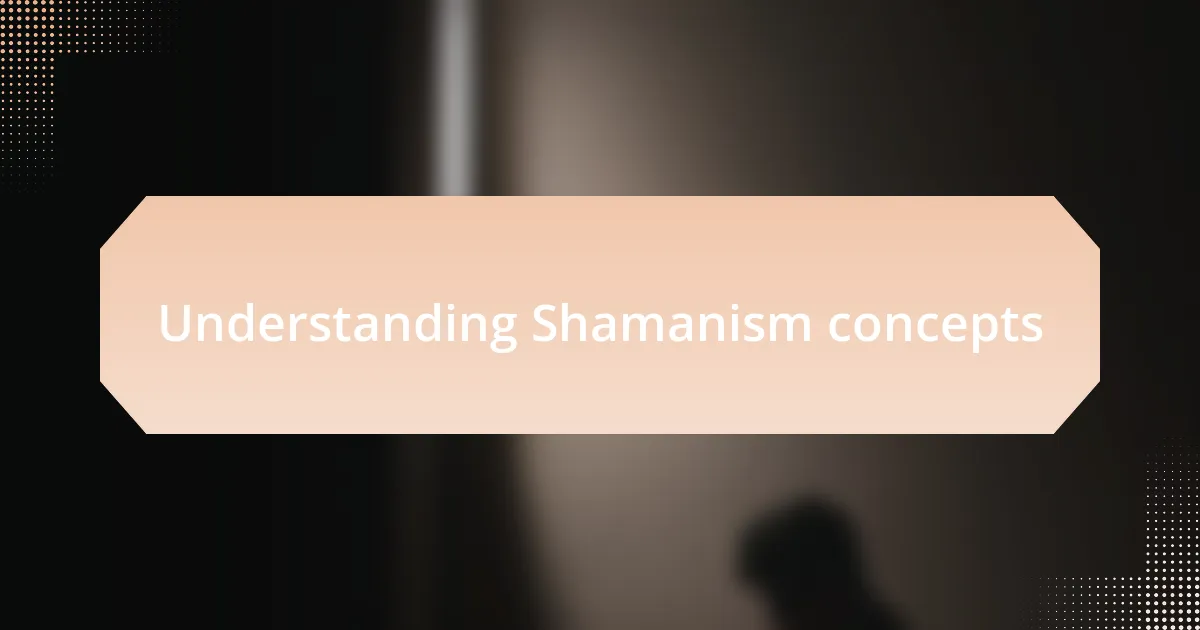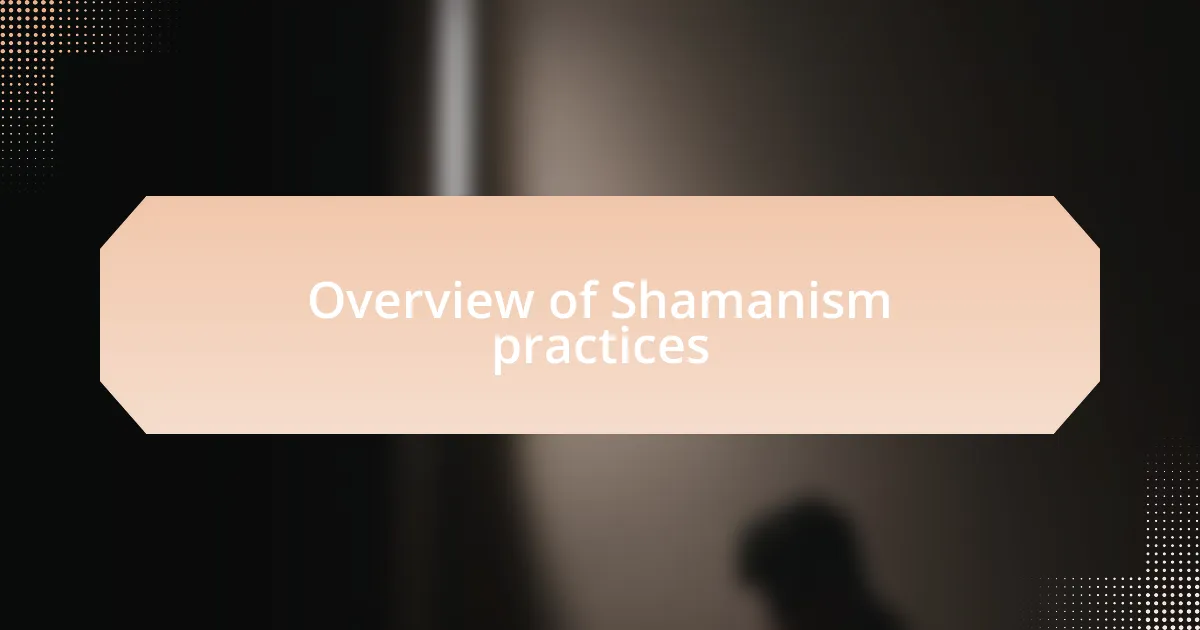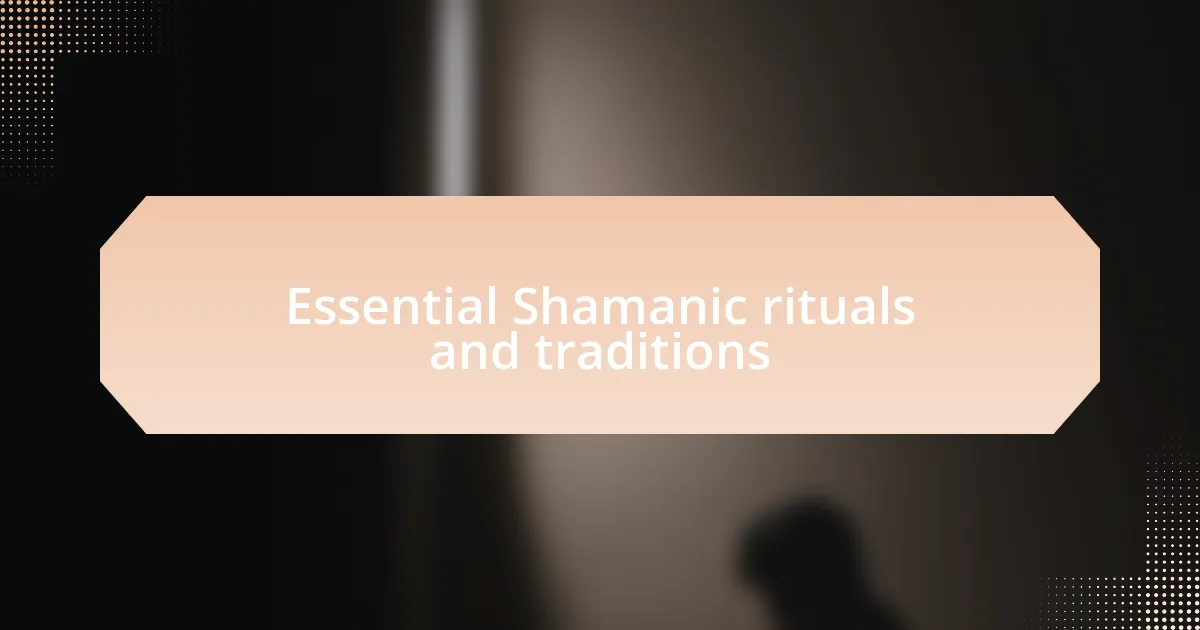Key takeaways:
- Shamanism emphasizes the interconnectedness of all nature, fostering reverence for the environment and deep personal connections through rituals.
- Key practices include using music, plants, and symbols in healing and divination, which enhance spiritual awareness and self-discovery.
- Essential texts such as “The Way of the Shaman” and “Shamanism: Archaic Techniques of Ecstasy” offer valuable insights into shamanic beliefs and practices across cultures.
- Personal shamanic guidance can be found through introspection, dream work, and creating sacred spaces, enriching one’s daily life and spiritual journey.

Understanding Shamanism concepts
Shamanism is deeply rooted in the idea that everything in nature is interconnected. This concept often evokes a feeling of reverence for the environment, which I experienced during a ceremony in a forest. The shaman facilitated a connection with the trees and stones around us, making me wonder: how often do we truly appreciate the community we share with the earth?
Another fascinating aspect of shamanism is the belief in spirit guides, which serve as sources of wisdom and support. I remember the first time I engaged in a guided meditation to discover my own spirit animal. The experience was profound and made me think about the ways we seek guidance in our daily lives. How can such connections with unseen energies influence our decision-making and emotional well-being?
The journey of a shaman is not just about seeking knowledge but also about healing, both for themselves and their community. Personally, I was moved when witnessing a healing ritual that restored balance and harmony. It left me pondering how our own experiences of pain and healing can shape our life paths. Can we tap into that energy for personal growth? I believe the answer lies within the traditions and practices of shamanism, urging us to explore this sacred relationship with ourselves and the world around us.

Overview of Shamanism practices
Shamanic practices encompass a range of rituals and techniques aimed at healing, divination, and spiritual connection. For instance, I once participated in a drumming circle where participants entered a trance state. This rhythmic journey allowed me to connect with energies I never knew existed, making me reflect on the profound ways in which music and rhythm can induce altered states of consciousness. Have you ever experienced a moment when sound transformed your perception of reality?
Another common element in shamanism is the use of plants for healing and vision quests, often termed entheogens. I’ve personally encountered the power of sacred herbs in ceremonies where they facilitated deep introspection. The guidance I received during these experiences was revelatory, prompting me to consider how nature can offer profound lessons if we allow ourselves to truly engage with it. Can these substances bridge our human experience with the spiritual realms?
Rituals in shamanism also often include elements such as the use of symbols and sacred objects, which hold significant meanings and stories. During one particular gathering, a shaman shared a beautifully crafted totem that depicted stories of ancestors. I felt an overwhelming connection to my lineage and started to question how our own histories affect our present selves. What if embracing these stories can empower us to navigate our modern lives? Through such practices, shamanism invites us to honor our past while we shape our future.

Key texts in Shamanism literature
Key texts in shamanism literature offer profound insights into the beliefs and practices of this spiritual tradition. One notable work is “The Way of the Shaman” by Michael Harner, which opened my eyes to the concept of the shaman as a bridge between worlds. I remember reading it on a rainy afternoon, and that moment ignited a deep curiosity within me about how different cultures perceive reality. Have you ever felt a book shift your perspective or understandings of spirituality?
Another essential text is “Shamanism: Archaic Techniques of Ecstasy” by Mircea Eliade. This book delves into historical shamanic practices across cultures, shedding light on the universal nature of shamanism. I found it fascinating how Eliade connected various rituals, helping me realize that despite our differences, the human quest for meaning remains constant. It makes me wonder, is there something inherently universal in our search for the sacred?
Lastly, “The Teachings of Don Juan” by Carlos Castaneda challenges and expands on traditional shamanic knowledge through personal narrative. As I navigated Castaneda’s experiences, I often reflected on my own encounters with altered states of consciousness. His vivid descriptions of the transformative power of plants and spiritual journeys led me to question how my own life experiences resonate with these ancient teachings. What if the wisdom we seek has always been present within our own stories?

Essential Shamanic rituals and traditions
Engaging with essential shamanic rituals opens a doorway to understanding how these practices connect the physical and spiritual worlds. For instance, one of the most profound rituals I’ve encountered is the sweat lodge ceremony, where participants enter a darkened space to experience purification through heat, steam, and shared intentions. The intimacy of this ceremony always struck me; I’ve felt a remarkable sense of renewal and clarity emerge from the enveloping darkness. Have you ever participated in a ritual that made you feel profoundly reborn?
Another cornerstone of shamanic traditions is the use of drumming and chanting to enter altered states of consciousness. I remember attending a gathering where participants drummed in harmony, and the rhythm became a heartbeat, synchronizing our collective energy. In those moments, it felt as though we were tapping into something ancient and powerful—something beyond our understanding. Isn’t it fascinating how sound can transport us beyond our present reality and connect us to a greater whole?
Animal spirit guides also feature prominently in shamanic practice, serving as symbolic allies in a shaman’s journey. During my own exploration into this aspect, I was guided to my spirit animal, a wise owl, which surprisingly mirrored my introspective nature. Each insight I gained from this connection leaves me wondering: do we all have guides lurking in the shadows, waiting for us to discover their teachings?

Finding personal Shamanism guidance
Finding personal guidance in shamanism often requires a willingness to look within and connect with one’s own spirit. I remember the first time I participated in a vision quest, a practice that left an indelible mark on my spiritual journey. In those silent hours of solitude, I found clarity tucked away in the whispers of nature, and it made me realize that the answers we seek often reside in our own hearts. Have you ever paused to listen to your inner voice?
Another avenue for finding personal shamanic guidance is through dream work, where the subconscious presents symbols and messages. One night, I had a vivid dream of walking alongside a flowing river. As I reflected on its meaning, I realized it mirrored my life’s journey—constantly moving, yet sometimes stagnant. This experience taught me to pay attention to my dreams as powerful teachers. How often do we overlook these nighttime narratives that could hold the key to our awakening?
Creating a personal altar can also be a profound way to invite shamanic guidance into your life. I crafted mine with meaningful items—stones, feathers, and photographs that resonate with my spirit. Over time, I felt a shift; each item became a focal point for meditation and reflection. It made me wonder, do we all have the power to create sacred spaces that connect us to deeper wisdom?

Integrating Shamanism into daily life
Incorporating shamanism into daily life can begin with simple rituals that ground us in the present moment. I remember feeling overwhelmed one morning, and I decided to take a few moments to light a candle and offer gratitude for the blessings in my life. This small act transformed my day, reminding me that we can infuse spirituality into even the busiest of schedules. Have you ever considered how a simple ritual could shift your perspective for the day?
Nature walks can be a powerful way to connect with the essence of shamanism. On one particularly crisp autumn day, I ventured into the woods and felt an instant sense of belonging among the trees and wildlife. Collaborating with nature in this way not only filled me with peace but also sparked a deeper appreciation for the universe’s rhythm. When was the last time you stepped outside to truly connect with the earth beneath your feet?
Additionally, incorporating shamanic practices like drumming and singing into your routine can enhance your spiritual connection. I found that setting aside a few minutes each week to drum allows me to tap into my inner rhythm and release tension. This practice has become a release for me, creating a space where I can express my emotions freely. Have you ever tried using sound as a means to communicate with your own spirit?

Sharing experiences with Shamanism community
Sharing experiences within the Shamanism community often reveals profound insights and connections among individuals. I recall attending a gathering where people openly shared their journeys. As each story unfolded, I felt an unspoken bond—a reminder that we each carry unique tales while navigating similar struggles. Have you ever witnessed how vulnerability in sharing can strengthen community ties?
I once participated in a circle where a member spoke about a guided journey they took with a spirit animal. Their description was so vivid that I could almost envision the experience myself. Listening to others’ encounters enriches my understanding of Shamanism, offering new perspectives that I hadn’t considered before. Don’t you think hearing diverse experiences is essential to deepening our own spiritual practice?
The beauty of sharing within this community is the exchange of wisdom that comes from different backgrounds and beliefs. At a local workshop, I met a woman who practices shamanism differently than I do, yet her approach resonated deeply with me. It made me realize that our interpretations of spiritual practices can complement each other, fostering growth. How has your interaction with others influenced your understanding of spirituality?